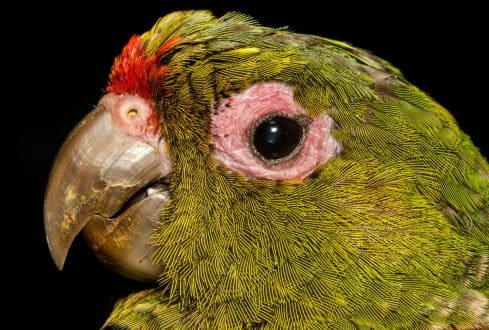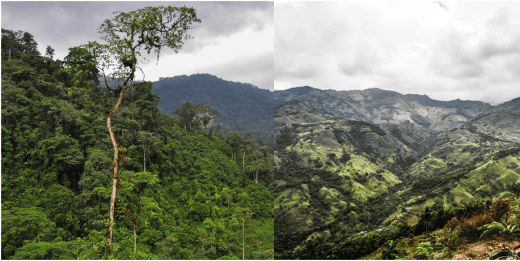- El Oro parakeets of the Andean Western Slopes in Southwest Ecuador have undergone a recent population bottleneck: From an effective population of 2,500 to 10,000 in 2000, the population has continued to decline.
- Somewhere between 60 and 90 percent of this population has been lost, such that today the effective population hovers precariously at less than 1,000 individuals.
- Conservationists think they have a solution, however: an ecological corridor that will extend to the north and south of Buenaventura Reserve, the single protected habitat in the region.
A pandemonium of El Oro parakeets passes over. The loose but synchronized breeding group calls raucously amongst themselves, ever-vigilant for small but nutritious canopy fruits.
Their feathers glow green, with a scarlet forehead, ruby tail, and flashes of bright cobalt and scarlet on the wings. They have presided over their own restricted belt of the Andean Western Slopes in Southwest Ecuador perhaps since speciating from their ‘fire-tailed’ cousins after the (geologically) abrupt formation of the Andes 6 to 10 million years ago.
Their home is a biodiversity hotspot: a mist-banked, epiphyte-laden mass of verdure. The slow march of evolution has ornamented their home with the diverse cries and furtive movements of countless species, carving niches from the billowing emerald canopy to the densely shadowed understory. Many of these species, like the parakeet, are endemic and highly range-restricted.

Yet after the tempered pace of their long history, the parakeets have much recent activity to broadcast with their shrill voices. What if they could tell us of the devastating landscape change they have witnessed, with their bird’s-eye-view? How all the beautiful emergent forest giants they preferred to perch in have been felled? How their treetop cornucopia has evaporated in the face of a plague of human-propagated grasses? How tinamou and tamandua, wood lizard and tree frog alike, are being replaced with cows?
Could they have any idea of the transformative conservation initiative now in store for them: an ecological corridor intended to stabilize their numbers and reverse their spiraling decline?
Humans likely first arrived in this region, where the wet Chocó and dry Tumbesian ecoregions intergrade, over 11,000 years ago. They hunted, gathered, and must have made their own kind of impact on the complex ecology of this stunning, Andean tropical mountain cloud forest. Still, it is only in the past century that the zone has lost 95 percent of tree cover.

Since the El Oro parakeet (Pyrrhura orcesi) was only recognized as a species in the 1980s, it is difficult to know the precise history of the parakeet’s population as they observed the course of progressive forest loss. What we do know, looking at genetic markers, is that El Oro parakeets have undergone a recent population bottleneck. From an effective population of 2,500 to 10,000 in 2000, the population has continued to decline. Somewhere between 60 and 90 percent of this population has been lost, such that today the effective population hovers precariously at less than 1,000 individuals.
Starkly complicating this situation is the fact that the El Oro parakeet breeds cooperatively. Rather than pairing up to raise clutches of offspring, the parakeets work in teams, often of six or ten individuals. A single pair within the group will mate, but together they share the tasks of egg incubation, chick feeding, and nest guarding. Though the topic is understudied, so far as we know this cooperative reproductive effort is highly unique among parrots worldwide.
For each group, at least under current conditions, the number of chicks surviving to adulthood is low. Although clutches of five or six eggs are not uncommon, many eggs are unsuccessful. There are many perils for a fresh clutch: predation by woodcreepers or mustellids, a hairline shell fracture that allows for bacterial infection of the developing embryo, or even inexperienced parents. Typically, only two to four fledglings will fly from an El Oro nest. For the parakeets to develop a cooperative breeding approach, the strategy must have benefited them. Yet, today, with their population numbers so depressed, their low reproductive rate may be a perilous artifact of adaptation to past conditions.

Up to 240 individuals of the remaining parakeet population find sanctuary in the glorious Buenaventura Reserve. Spanning only 1,800 hectares (about 4,450 acres), Buenaventura is a haven to a vast array of vulnerable species, many endemic to this sliver of the Andean western slopes. So far, it is known that the refuge harbors at least 14 globally-threatened bird species, five globally-threatened herps, and seven globally-threatened plants. However, Southwest Ecuador is biologically understudied, so there are certain to be many more reclusive or uncommon species awaiting discovery there.
The reserve is owned and managed by the Ecuadorian avian conservation non-profit Fundación Jocotoco. The group has ambitious plans to expand the reserve — in fact, plans are currently in motion for a 1,680-acre expansion. Still, the blatant truth remains: Buenaventura is the single protected habitat in this region. Outside the reserve, habitat loss and fragmentation are rampant. The dearth of native habitat creates a crisis of connectivity: remnant wildlife with low capability to cross gaps becomes marooned in forest fragments. In such scenarios, random environmental or human-driven events can lead directly to local extinctions. In a region so replete with vulnerable and range-restricted species, a few unfortunate events can result in the extinction of species at large.
The coveted solution, a hefty ballast against local faunal collapse, is an ecological corridor. This land protection scheme will extend to the north and south of Buenaventura Reserve, encompassing many private lands under a progressive model recognizing the value of strategically focused landscape conservation for facilitating animal movement across the habitat matrix. A team from the University of Freiburg, funded by the conservation nonprofit Fundacion Loro Parque, has been conducting biological fieldwork to harvest requisite data for informed management of the El Oro parakeet.
The university, the local government, Ecuador’s Instituto Nacional de Biodiversidad (INB), and Fundacion Jocotoco are collaborating to translate a paper ecological corridor agreement into a wooden reality. Individual landowners will sign into an easement scheme, incentivized with reductions to their annual land tax. The reforestation of riparian zones in particular will be encouraged, and will increase water security for downstream settlements and agriculture.

As a result of the international interest and attention attracted to the region, this project is yielding further fruits. Now, a project to establish three new nationally protected forests within the corridor zone is underway. Furthermore, to truly capture the hearts and minds of future local landholders, an environmental education program encompassing the several districts of the corridor was initiated last year by the University of Freiburg. This year, the effort is expanding, with the INB sponsoring further educators and workshops in more schools.
Older farmers outside Buenaventura Reserve remember a time when large flocks of El Oros passed over their heads. They can fondly describe their sociable chattering, or seeing them feeding together off canopy fruits. Some explain how they used to follow the parakeets back to discover their nesting cavities in palm groves.
Today, outside Buenaventura Reserve, this intimacy with the parakeets is no longer possible. Yet, within the reserve, where habitat has been protected and restored since the reserve’s inauguration in 1999, the El Oros have flourished. The reserve population increased, and flocks became larger. In Buenaventura, within the parakeet’s preferred elevational belt, one is sure to hear them calling, emerging then disappearing into the pervasive mist. Now, with this habitat recovery being spread to the north and south of Buenaventura across the avenue of the ecological corridor, we drive towards the rebound of flocks widely throughout their historical distribution.
The El Oro parakeets have roamed these skies for at least six million years. With an ecological corridor maintaining multiple, intermixing populations, conservationists aim to guarantee that no year is the last year for the El Oro parakeet.